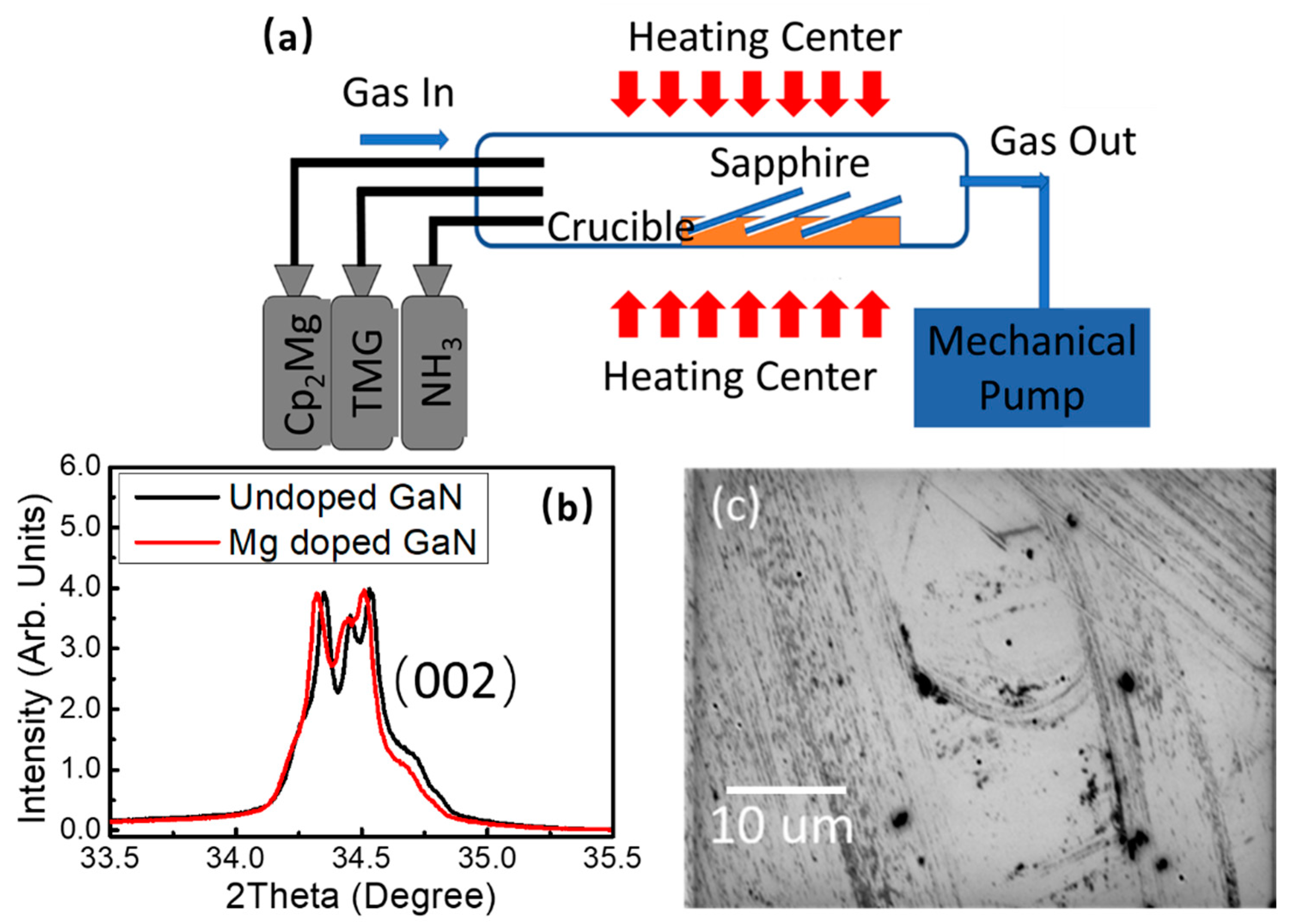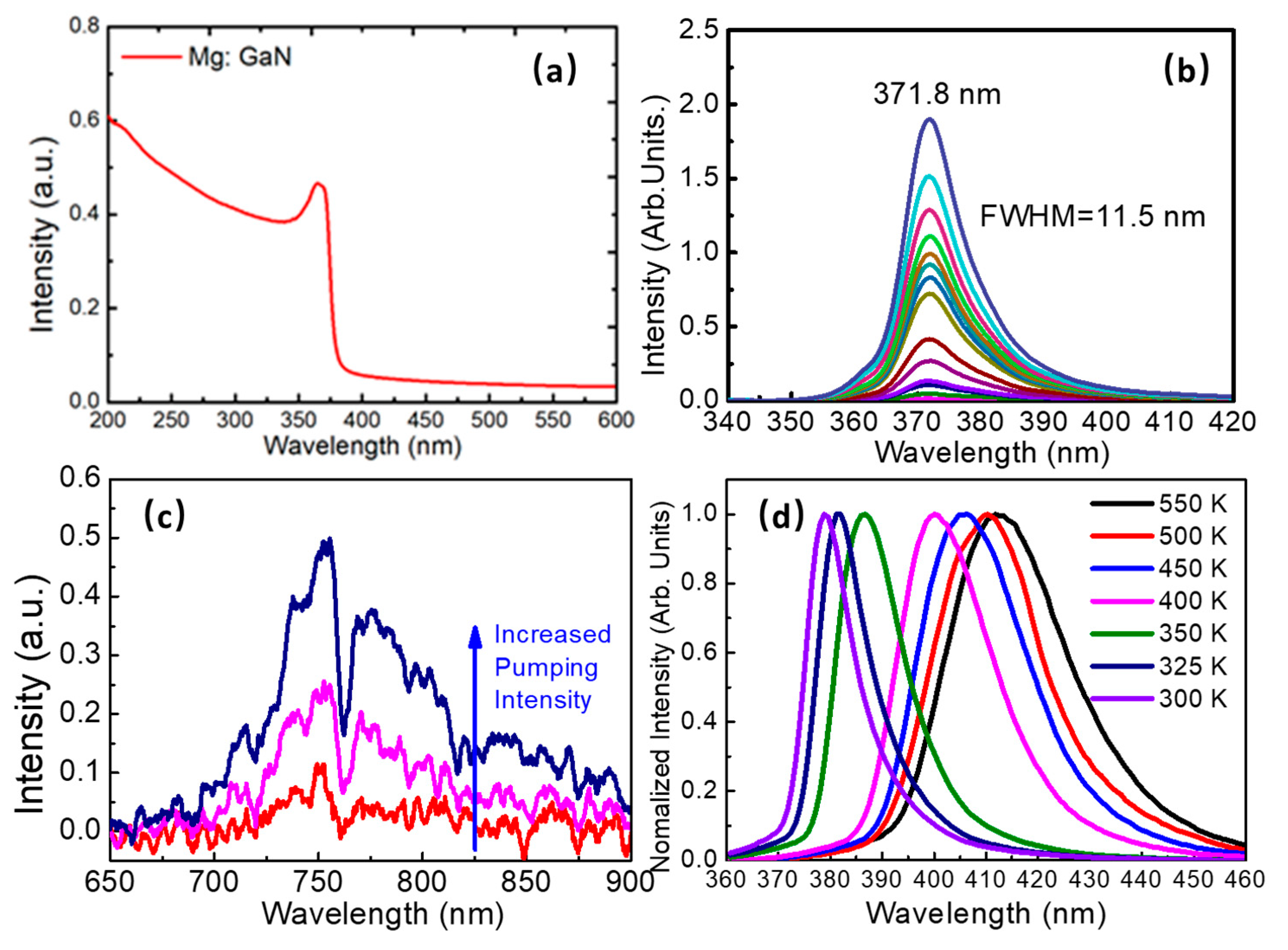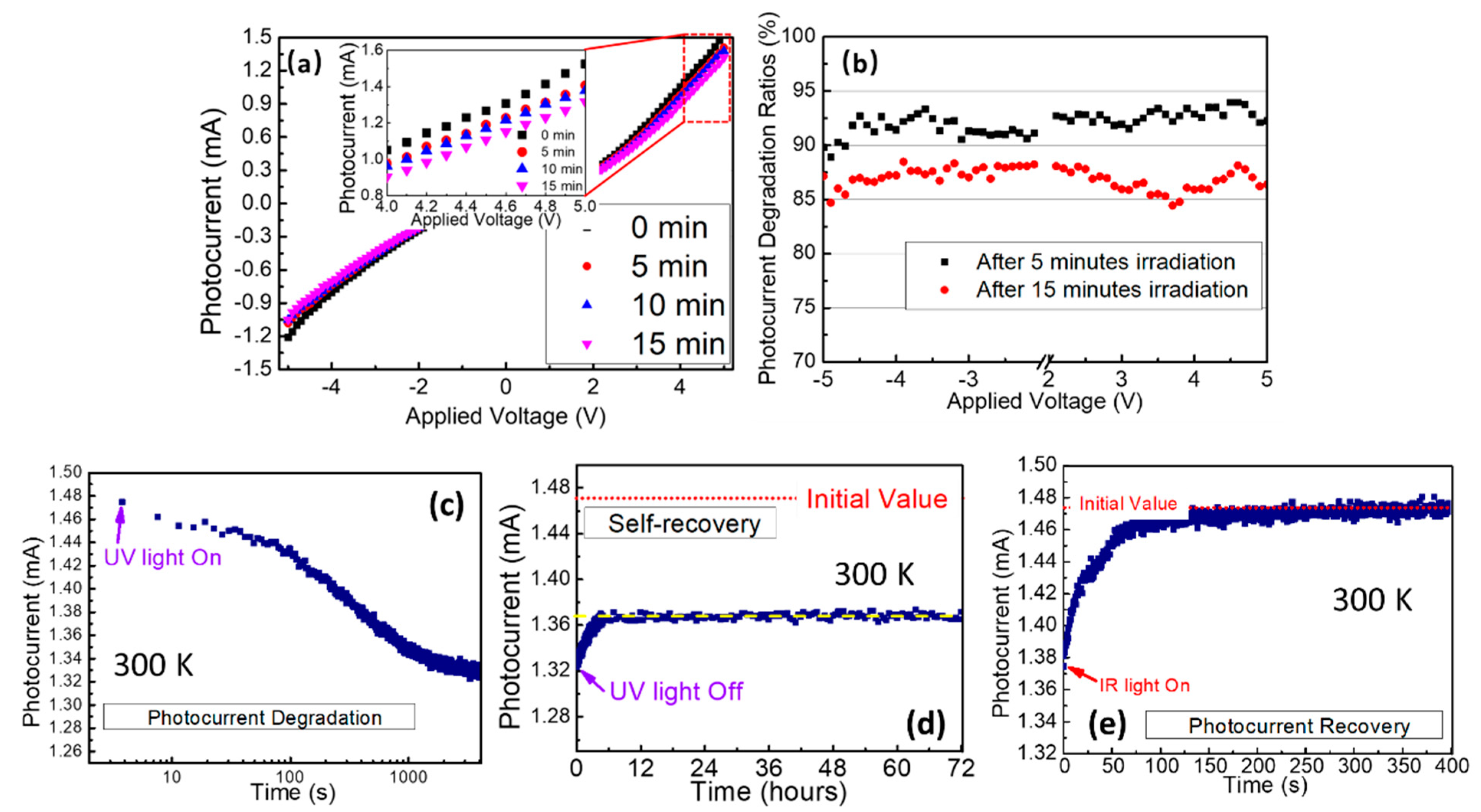Mechanism of Photocurrent Degradation and Contactless Healing in p-Type Mg-Doped Gallium Nitride Thin Films
Abstract
:1. Introduction
2. Materials and Methods
3. Results
4. Conclusions
Author Contributions
Funding
Institutional Review Board Statement
Informed Consent Statement
Data Availability Statement
Conflicts of Interest
References
- Lindroos, J.; Savin, H. Review of light-induced degradation in crystalline silicon solar cells. Sol. Energy Mater. Sol. Cells 2016, 147, 115–126. [Google Scholar] [CrossRef]
- Chen, B.; Song, J.; Dai, X.; Liu, Y.; Rudd, P.N.; Hong, X.; Huang, J. Synergistic effect of elevated device temperature and excess charge carriers on the rapid light-induced degradation of perovskite solar cells. Adv. Mater. 2019, 31, 1902413. [Google Scholar] [CrossRef] [PubMed]
- Xu, R.P.; Li, Y.Q.; Jin, T.Y.; Liu, Y.Q.; Bao, Q.Y.; O’Carroll, C.; Tang, J.X. In situ observation of light illumination-induced degradation in organometal mixed-halide perovskite films. ACS Appl. Mater. Int. 2018, 10, 6737–6746. [Google Scholar] [CrossRef] [PubMed]
- Lee, H.; Ko, D.; Lee, C. Direct evidence of ion-migration-induced degradation of ultrabright perovskite light-emitting diodes. ACS Appl. Mater. Int. 2019, 11, 11667–11673. [Google Scholar] [CrossRef] [PubMed]
- Güy, N.; Özacar, M. Visible light-induced degradation of indigo carmine over ZnFe2O4/Tannin/ZnO: Role of tannin as a modifier and its degradation mechanism. Int. J. Hydrogen Energy 2018, 43, 8779–8793. [Google Scholar] [CrossRef]
- Liu, X.; Han, Q.; Liu, Y.; Xie, C.; Yang, C.; Niu, D.; Li, Y.; Wang, H.; Xia, L.; Yuan, Y.; et al. Light-induced degradation and self-healing inside CH3NH3PbI3-based solar cells. Appl. Phys. Lett. 2020, 116, 253303. [Google Scholar] [CrossRef]
- Shahivandi, H.; Vaezzadeh, M.; Saeidi, M. Theory of light-induced degradation in perovskite solar cells. Sol. Energy Mater. Sol. Cells 2020, 208, 110383. [Google Scholar] [CrossRef]
- Modanese, C.; Wagner, M.; Wolny, F.; Oehlke, A.; Laine, H.S.; Inglese, A.; Vahlman, H.; Yli-Koski, M.; Savin, H. Impact of copper on light-induced degradation in Czochralski silicon PERC solar cells. Sol. Energy Mater. Sol. Cells 2018, 186, 373–377. [Google Scholar] [CrossRef]
- Chakraborty, S.; Huang, Y.; Wilson, M.; Aberle, A.G.; Li, J.B. Mitigating light and elevated temperature induced degradation in multicrystalline silicon wafers and PERC solar cells using phosphorus diffusion gettering. Phys. Status Solidi 2018, 215, 1800160. [Google Scholar] [CrossRef]
- Nakayashiki, K.; Hofstetter, J.; Morishige, A.E.; Li, T.T.; Needleman, D.B.; Jensen, M.A.; Buonassisi, T. Engineering solutions and root-cause analysis for light-induced degradation in p-type multicrystalline silicon PERC modules. IEEE J. Photovolt. 2016, 6, 860–868. [Google Scholar] [CrossRef]
- Fertig, F.; Lantzsch, R.; Frühauf, F.; Kersten, F.; Schütze, M.; Taubitz, C.; Lindroos, J.; Müller, J.W. Excessive light-induced degradation in boron-doped Cz silicon PERC triggered by dark annealing. Sol. Energy Mater. Sol. Cells 2019, 200, 109968. [Google Scholar] [CrossRef]
- Vahlman, H.; Wagner, M.; Wolny, F.; Krause, A.; Laine, H.; Inglese, A.; Yli-Koski, M.; Savin, H. Light-induced degradation in quasi-monocrystalline silicon PERC solar cells: Indications on involvement of copper. Phys. Status Solidi 2017, 214, 1700321. [Google Scholar] [CrossRef]
- Sen, C.; Chan, C.; Hamer, P.; Wright, M.; Chong, C.; Hallam, B.; Abbott, M. Eliminating light-and elevated temperature-induced degradation in P-type PERC solar cells by a two-step thermal process. Sol. Energy Mater. Sol. Cells 2020, 209, 110470. [Google Scholar] [CrossRef]
- Polyakov, A.Y.; Smirnov, N.B.; Shchemerov, I.V.; Yakimov, E.B.; Yang, J.; Ren, F.; Yang, G.; Kim, J.; Kuramata, A.; Pearton, S.J. Point defect induced degradation of electrical properties of Ga2O3 by 10 MeV proton damage. Appl. Phys. Lett. 2018, 112, 032107. [Google Scholar] [CrossRef] [Green Version]
- Gan, L.; Xu, L.; Shang, S.; Zhou, X.; Meng, L. Visible light induced methylene blue dye degradation photo-catalyzed by WO3/graphene nanocomposites and the mechanism. Ceram. Int. 2016, 42, 15235–15241. [Google Scholar] [CrossRef]
- Yamada, K.; Watanabe, W.; Toma, T.; Itoh, K.; Nishii, J. In situ observation of photoinduced refractive-index changes in filaments formed in glasses by femtosecond laser pulses. Opt. Lett. 2001, 26, 19–21. [Google Scholar] [CrossRef]
- Xu, C.; Zhang, J.; Xu, L.; Zhao, H. Mechanism of photochromic effect in Pb (Zr,Ti)O3 and (Pb,La)(Zr,Ti)O3 ceramics under violet/infrared light illumination. J. Appl. Phys. 2015, 117, 023107. [Google Scholar] [CrossRef]
- Xu, L.; Zhu, R.; Xu, C. Broadband photochromic effect and photoluminescence modulation in rare-earth-doped (Pb,La)(Zr,Ti)O3 ceramics. Chin. Opt. Lett. 2020, 18, 091403. [Google Scholar] [CrossRef]
- Nampalli, N.; Laine, H.S.; Colwell, J.; Vähänissi, V.; Inglese, A.; Modanese, C.; Vahlman, H.; Yli-Koski, M.; Savin, H. Rapid thermal anneal activates light induced degradation due to copper redistribution. Appl. Phys. Lett. 2018, 113, 032104. [Google Scholar] [CrossRef] [Green Version]
- Zhang, S.; Peng, J.; Qian, H.; Shen, H.; Wei, Q.; Lian, W.; Ni, Z.; Jie, J.; Zhang, X.; Xie, L. The impact of thermal treatment on light-induced degradation of multicrystalline silicon PERC solar cell. Energies 2019, 12, 416. [Google Scholar] [CrossRef] [Green Version]
- Hautakangas, S.; Oila, J.; Alatalo, M.; Saarinen, K.; Liszkay, L.; Seghier, D.; Gislason, H.P. Vacancy defects as compensating centers in Mg-doped GaN. Phys. Rev. Lett. 2003, 90, 137402. [Google Scholar] [CrossRef] [PubMed] [Green Version]
- Saarinen, K.; Nissilä, J.; Hautojärvi, P.; Likonen, J.; Suski, T.; Grzegory, I.; Lucznik, B.; Porowski, S. The influence of Mg doping on the formation of Ga vacancies and negative ions in GaN bulk crystals. Appl. Phys. Lett. 1999, 75, 2441–2443. [Google Scholar] [CrossRef]
- Lim, J.; Kim, M.; Park, H.H.; Jung, H.; Lim, S.; Hao, X.; Choi, E.; Park, S.; Lee, M.; Liu, Z.; et al. Kinetics of light-induced degradation in semi-transparent perovskite solar cells. Sol. Energy Mater. Sol. Cells 2021, 219, 110776. [Google Scholar] [CrossRef]
- Nie, W.; Blancon, J.C.; Neukirch, A.J.; Appavoo, K.; Tsai, H.; Chhowalla, M.; Alam, M.A.; Sfeir, M.Y.; Katan, C.; Even, J.; et al. Light-activated photocurrent degradation and self-healing in perovskite solar cells. Nat. Commun. 2016, 7, 11574. [Google Scholar] [CrossRef] [PubMed] [Green Version]





| Growth Temperature | Flow Rate | Vacuum Pressure | Growth Time | Annealing Temperature | |
|---|---|---|---|---|---|
| First Step | 520 °C | TMG: 8.3 µmol/min NH3: 0.5 sccm | 80 Torr | 15 min | - |
| Second Step | 850 °C | Cp2Mg: 0.4 µmol/min TMG: 8.3 µmol/min NH3: 0.5 sccm | 80 Torr | 120 min | - |
| Third Step | - | N2: 60 sccm | - | - | 750 °C |
| Light Illumination | Magnetic Intensity | Hall Coefficient | Carrier Concentration |
|---|---|---|---|
| Before UV Illumination | 600 mT | 9.33 cm³/C | 6.69 × 1017 cm−3 |
| After UV Illumination for 5 min | 600 mT | 14.17 cm³/C | 4.40 × 1017 cm−3 |
| After Infrared light Illumination for 5 min | 600 mT | 9.74 cm³/C | 6.38 × 1017 cm−3 |
Publisher’s Note: MDPI stays neutral with regard to jurisdictional claims in published maps and institutional affiliations. |
© 2022 by the authors. Licensee MDPI, Basel, Switzerland. This article is an open access article distributed under the terms and conditions of the Creative Commons Attribution (CC BY) license (https://creativecommons.org/licenses/by/4.0/).
Share and Cite
Wu, X.; Li, W.; Chen, Q.; Xu, C.; Wang, J.; Wu, L.; Liu, G.; Wang, W.; Li, T.; Chen, P.; et al. Mechanism of Photocurrent Degradation and Contactless Healing in p-Type Mg-Doped Gallium Nitride Thin Films. Nanomaterials 2022, 12, 899. https://doi.org/10.3390/nano12060899
Wu X, Li W, Chen Q, Xu C, Wang J, Wu L, Liu G, Wang W, Li T, Chen P, et al. Mechanism of Photocurrent Degradation and Contactless Healing in p-Type Mg-Doped Gallium Nitride Thin Films. Nanomaterials. 2022; 12(6):899. https://doi.org/10.3390/nano12060899
Chicago/Turabian StyleWu, Xiaoyan, Wei Li, Qingrong Chen, Caixia Xu, Jiamian Wang, Lingyuan Wu, Guodong Liu, Weiping Wang, Ting Li, Ping Chen, and et al. 2022. "Mechanism of Photocurrent Degradation and Contactless Healing in p-Type Mg-Doped Gallium Nitride Thin Films" Nanomaterials 12, no. 6: 899. https://doi.org/10.3390/nano12060899
APA StyleWu, X., Li, W., Chen, Q., Xu, C., Wang, J., Wu, L., Liu, G., Wang, W., Li, T., Chen, P., & Xu, L. (2022). Mechanism of Photocurrent Degradation and Contactless Healing in p-Type Mg-Doped Gallium Nitride Thin Films. Nanomaterials, 12(6), 899. https://doi.org/10.3390/nano12060899






